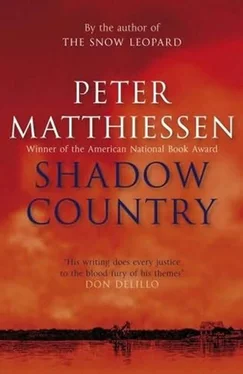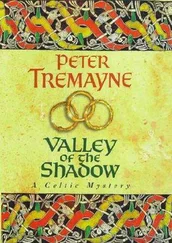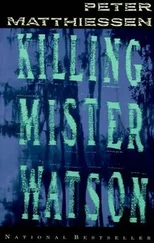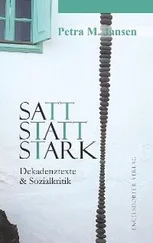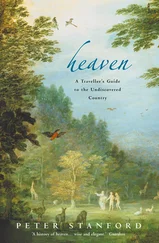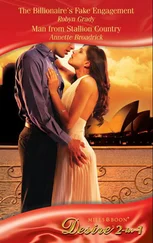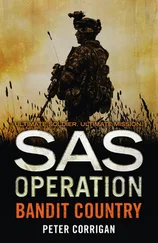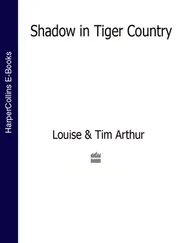
From the Frenchman I’d learned the names of his plume buyers and done my best to supply ’em. I even had neighbors helping out while the egrets lasted, cause people was dirt poor at Chokoloskee, all but Smallwoods. Storters still grew cane at Half Way Creek, Will Wiggins, too, but nobody lived there anymore. Mr. D. D. House had moved his cane field from Half Way Creek to the black soil of a shot-out rookery northeast of Chatham Bend that we called House Hammock. C. G. McKinney raised his garden produce on Injun mounds up Turner River and Charlie T. Boggess had a plot at Sandfly Key. Ted Smallwood had two hundred and fifty alligator pear trees on the old Santini claim, shipped pears by the barrel to Punta Gorda and on north by rail, five cents apiece. But most of ’em on Chokoloskee had give up their gardens. Too much rain or not enough for shell mound soil, which has no minerals to speak of: that soil got tuckered out in a few years, same as the women.
Course the tame Injuns, Seminoles and such, was taking the last plume birds same as us, and them rookeries over by Lake Okeechobee was shot out first. By the turn of the century the east coast birds was gone and the west coast birds was going and the white plumes was bringing twice their weight in gold. Men would fight over egrets and shoot to kill. At Flamingo, the Roberts boys went partners with the Bradleys and for a few years they done all right back in Cuthbert Lake, but elsewhere them birds growed so scarce that hunters would set up at night guarding what small rookeries was left. Them Audibones was agitating harder’n ever, and in 1901, plume hunting was forbidden: our native state of Florida had passed a law against our good old native way of living.
Most of us thought that law was meant to simmer down them birdlovers but all it ever done was put the price up. Only man who give a good goddamn about enforcement was Guy Bradley who got hisself hired the first Audibone warden in south Florida and took his job too serious for his own good.
When Guy was shot dead off Flamingo, July 19-0-5, rumors blamed Watson. Then another warden got axed to death near Punta Gorda and that one was laid on Watson, too. Course every man at Flamingo and Punta Gorda knew the names of the real killers but no one turned ’em in. I ain’t saying that’s good, I got my doubts, but any local judge knows better than to mess with an old-time clan that is only taking the wild creaturs that is theirs by God-given right.
When a third warden got wiped out in Carolina, somebody hollered, Well, E. J. Watson come from Carolina! Made no sense, but all the same, the man’s bad reputation come in handy for anybody in south Florida who was out to cover up a killing. And all this while, not one word said about those Tuckers.
Before my daddy crippled hisself up with his own ax and I moved south to House Hammock to help out, I worked as guide for a Yankee sportsman, Mr. Dimock. Like most sports, Mr. A. W. Dimock shot at anything in sight, deer, birds, and gators, crocs, and even manatees. We harpooned big sawfish from Chatham River all the way south to Cape Sable, hacked off the saw to sell for tourist souvenirs, left the rest to rot. Them big ol’ fish from long ago is very scarce today.
Mr. Dimock wrote up his adventures in a famous book called Florida Enchantments. Had his son along snapping pictures for his book that spent most of the day with his head in a black bag. The photo of his guide was kind of murky but it might been me, cause the man from the east coast who took my place got pulled overboard by a sawfish, split his guts out. Weren’t familiar with the way we done things in the Islands.
A. W. Dimock was very curious about Ed Watson, who was mostly what us local people talked about in them days. Mr. Dimock put our tales into his book. I couldn’t read but I was told about it good. Mr. Dimock called E. J. Watson “J. E. Wilson” cause his book claimed Wilson had killed seven in these parts and he didn’t want Ed to take him into court for heartburn.
Sure, the men suspected Ed of maybe two or three, but I’m damned if I know who them seven might of been, unless they was black cane cutters on his plantation. And if his own neighbors never knowed about them seven, how did that old Yankee find it out? If Ed was killing all them people, seems funny their own families never mentioned it.
Anyways, he weren’t the only feller in this section who had took a life, not by no means. Among plume hunters especially, there was murdering aplenty: rob the plumes, then slip away like otters through the creeks, hide out far back into the Glades. Sheriff never cared much who hid out back in the rivers. If a few went missing, the law seen it as good riddance and was probably right.

In the early days, Mister Ed Watson was touchy about people tellin slander, but he always enjoyed the attention he got for knowing famous outlaws in the Territories and he made the most of them bad stories about himself. Didn’t encourage ’em so much as not quite deny ’em, cause his reputation as a fast gun and willing to use it kept other men from staking claims anywhere near him.
Good dry ground was running out along the southwest coast but very few tried to settle what was left. People came and then they went: they never stayed long. After Tuckers, that country emptied out all the way south to Rodgers River. Used to be three plantations up that river, royal palms, date palms, too, and tamarinds. Well, quit-claims to all of ’em was up for sale and had no buyers. After all the hard years Atwells put in, their gardens was long gone, cabins sagging, cisterns lined with slime and rot from animals that fell in trying to get their water. Later years when the Storter boys went up in there seining for mullet, they seen crude-painted skull-and-crossbone signs stuck into the bank. Might of been a warning or it might of been a certain feller’s idea of joke, most likely both.
Around Lost Man’s there was two strong families left. Hardens lived on Hog Key and Wood Key, just north of Lost Man’s River, that was one clan; the other was Old Man James Hamilton and family and their Daniels kin south of the river mouth. That was the long white coral beach Mister Watson had his eye on, and all them people knew that, too, because when I married young Gert Hamilton I told ’em. I was helpin Hamiltons construct a shell road through the jungle to a big Injun mound we called Royal Palm Hammock but along with that I ran his ship for Mister Watson.
Headed south to Flamingo or Key West, Mister Watson and me used to enjoy the view of all them royal palms back of Lost Man’s Beach. One of them cattle kings, Mr. Cole, claimed them palms was goin to waste out in the wilderness so he had ’em all grubbed out, using our dead-broke Island men for the hard labor; he was out to prettify the city streets to bring more tourists to Fort Myers. Tropical paradise, y’know. Course most of them street palms died in the first dry spell because nobody thought to water ’em, so they might’s well have stood where they belonged. Like the Boss said, Cole should of ordered up some gumbo-limbos-what us local folks call the tourist tree for just a joke on account of that red skin bark that’s always peeling, get it?
After the wild things was all gone, there weren’t much left but donkey work digging clams and ricking buttonwood for charcoal, so our whole gang went over to Pavilion Key for the clam fishery that supplied the new Yankee cannery built at Caxambas. My uncle Jim Daniels was the captain of the dredge and my mother and George Roe set up a store and post office. Aunt Josie was there, too, with her latest husband. Josie took seven by the time the smoke cleared, counting the man that she took twice, and she seen every last damned one of ’em into his grave.
Читать дальше
